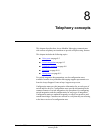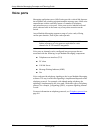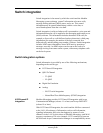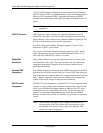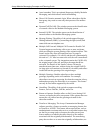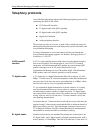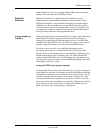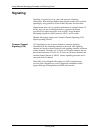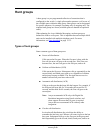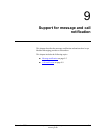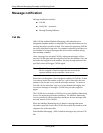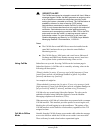
Avaya Modular Messaging Concepts and Planning Guide
8-8 November 2004
Avaya Modular Messaging Concepts and
Planning Guide
Telephony protocols
Avaya Modular Messaging supports the following telephony protocols for
connecting the MAS to the switch:
! H.323-based IP interface
! T1 digital trunks with QSIG signaling
! E1 digital trunks with QSIG signaling
! Digital Set Emulation
! Analog telephony interface
This section provides an overview of each of these telephony protocols
and describes the characteristics and deployment options associated with
Avaya Modular Messaging.
For more information on voice card options and the port boards that
Avaya Modular Messaging supports, see Modular Messaging Release 2
Installation, 11-300122.
H.323-based IP
interface
H.323 is a call signalling protocol that relies on packet-based networks,
such as an IP network, for transmission of voice. In H.323-based IP
integration, call information and MWI updates are passed using QSIG
protocol messages on an H.323 packet between the Avaya
Communication Manager (Avaya CM) and the MAS. Call information,
MWI updates, and voice data are passed over an IP network.
T1 digital trunks A T1 connection is a digital transmission link with a capacity of 1.544
MBps. T1 trunks carry 24 concurrent telephone connections multiplexed
into time slots. Each time slot carries sound digitized at 64 KBps, which
can be used to convey voice or signaling information.
T1 is a standard for digital transmission in North America. It is widely
used by telecommunications service providers to connect to remote
locations and to connect switches to public networks. T1 digital trunks
can connect MAS units to the switch. This enables the use of simplified
wiring, with one wire for 24 time slots: 23 bearer channels (voice) and
one signaling channel (data).
Customers that use T1 between their switch and service provider have the
option of using E1 between the switch and the MA to obtain the benefit of
higher port density per card. Typically though, customers choose to use
T1 to match the interface used for external and internal communication
and establish a consistent model for switch provisioning.
E1 digital trunks Outside North America, the standard for primary rate connections is an
E1 digital trunk. An E1 digital trunk is a digital transmission link with a
with a capacity of 2.048 MBps. This link is divided into 32 time slots: 30




